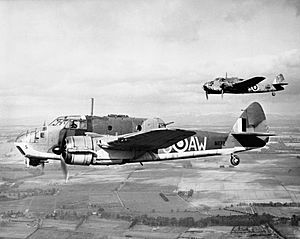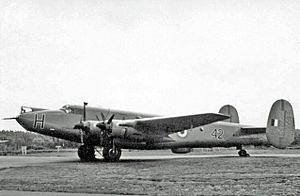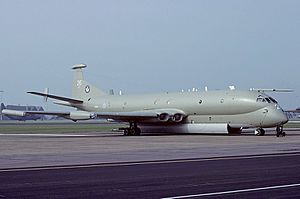No. 42 Squadron RAF facts for kids
Quick facts for kids No. 42 Squadron RAF |
|
|---|---|

No. 42 Squadron badge
|
|
| Active | 1 April 1916 – 1 April 1918 (RFC) 1 April 1918 – 26 June 1919 (RAF) 14 December 1936 – 30 June 1945 1 July 1945 – 30 December 1945 1 October 1946 – 15 October 1947 28 June 1952 – 26 May 2011 |
| Country | |
| Branch | |
| Motto(s) | Latin: Fortiter in re (Translation: "Bravely into action") |
| Battle honours | Western Front, 1916–1918*: Italian Front & Adriatic, 1917–1918*: Somme, 1916 Arras, 1917: Ypres, 1917: Lys: Channel & North Sea, 1939–1942*: Biscay, 1940*: Baltic, 1941*: Fortress Europe, 1941: Pacific, 1943–1945: Eastern Waters, 1943*: Arakan, 1943–1944*: Manipur, 1944*: Burma, 1944–1945: South Atlantic, 1982: Gulf, 1991. Honours marked with an asterisk (*) are those emblazoned on the Squadron Standard |
| Insignia | |
| Squadron Badge heraldry | On a terrestrial globe, a figure of Perseus No. 42 Squadron was the 1st to use the Bristol Perseus engine and this accounts for the presence of Perseus in the badge; he was known always to achieve his object and destroy his enemies and he stands in front of a globe to signify his activities over many lands and seas |
| Squadron Codes | QD (Allocated Apr 1939 – Sep 1939, but probably not used) AW (Sep 1939 – Jun 1942 1943 – Dec 1945) QM (Oct 1946 – Oct 1947) A (Jun 1952 – 1956) 42 (1956–1968) |
No. 42 Squadron was a famous part of the Royal Air Force, the UK's air force. This squadron played many important roles throughout history. It helped soldiers on the ground during World War I and flew different types of missions in World War II. Later, it trained pilots to fly the powerful Nimrod MR.2 aircraft. The squadron officially stopped operating on May 26, 2011.
Contents
History of No. 42 Squadron
World War I Missions
No. 42 Squadron was formed on April 1, 1916. It started with crews from No. 19 Squadron of the Royal Flying Corps. Their main job during World War I was to fly reconnaissance missions. This meant they would fly over enemy lines to gather information.
They used aircraft like the Royal Aircraft Factory BE.2 and later the Royal Aircraft Factory R.E.8. The squadron served on both the Western Front in France and the Austro-Italian Front. After the war, the squadron was disbanded on June 26, 1919.
World War II Operations
No. 42 Squadron was brought back on December 14, 1936. They first flew Vickers Vildebeest planes. In January 1940, they switched to Bristol Beaufort aircraft. These planes were used for bombing missions.
During the Burma campaign, the squadron flew Blenheim bombers. Later, in 1943, they became a fighter-bomber unit, flying Hawker Hurricanes. The squadron was disbanded on June 30, 1945. However, it was immediately reformed the next day by renumbering No. 146 Squadron. They then flew Republic Thunderbolts Mk.IIs. The squadron continued to fight until the Burma campaign ended. It was disbanded again on December 30, 1945.
Post-War Era: Beaufighters and Shackletons
On October 1, 1946, No. 42 Squadron was reformed once more. This time, they were based at RAF Thorney Island. They flew Bristol Beaufighter aircraft. These planes were used for striking targets at sea as part of RAF Coastal Command. The squadron was disbanded again on October 15, 1947.
On June 28, 1952, No. 42 Squadron was reformed at RAF St. Eval. They began flying Avro Shackleton MR.1 planes. These aircraft were used for maritime reconnaissance, meaning they searched the seas. In 1954, the squadron upgraded to the Shackleton MR.2. Sadly, in 1955, two of their Shackleton MR.2s disappeared near Fastnet Rock.
The squadron moved to RAF St. Mawgan in October 1958. In 1961, they helped with relief efforts in Jamaica after Hurricane Hattie. They upgraded to the Shackleton MR.3 in December 1965. In 1966, the squadron helped enforce a blockade of the port of Beira in Mozambique. This was to stop oil shipments to Rhodesia.
Nimrod Aircraft: A New Era (1971–2011)
In April 1971, No. 42 (Torpedo Bomber) Squadron started using the Hawker Siddeley Nimrod MR.1. This was a big change for the squadron.
No. 42 (TB) Squadron was the first Nimrod unit to arrive at Wideawake Airfield in 1982. This happened shortly after the Falkland Islands were invaded. In 1984, one of their crews won the Fincastle Trophy. This is a competition for maritime patrol aircraft. In 1985, a Nimrod MR.2 from the squadron helped find the wreck of the Virgin Atlantic Challenger boat.
In June 1990, No. 42 (TB) Squadron won the Fincastle Trophy again. In October 1990, the squadron sent crews to Oman and Cyprus. This was part of Operation Granby, during the Gulf War. One Nimrod, XV244 (nicknamed Battle Star 42), completed 14 missions. It was also credited with sinking four enemy ships. One crew received a special award for their success in dangerous conditions.
The squadron stopped being a front-line unit in October 1992. However, it was reformed as No. 42 (Reserve) Squadron. It became the Operational Conversion Unit (OCU) for the Nimrod. This meant they trained new pilots to fly the Nimrod.
No. 42 (R) Squadron made the Nimrod's last visit to Gibraltar in March 2010. The squadron flew its final Nimrod MR.2 flight on March 30, 2010. The squadron was expected to train pilots for a new Nimrod MRA.4. However, this project was cancelled. No. 42 (R) Squadron officially disbanded on May 26, 2011.
Aircraft Flown by No. 42 Squadron
No. 42 Squadron used many different types of aircraft throughout its history. Each plane helped them perform their important missions.
| From | To | Aircraft | Version |
|---|---|---|---|
| April 1916 | August 1916 | B.E.2 | 2d |
| April 1916 | April 1917 | B.E.2 | 2e |
| April 1917 | February 1919 | R.E.8 | |
| December 1936 | December 1937 | Vickers Vildebeest | Mk.III |
| January 1937 | March 1937 | Vickers Vildebeest | Mk.I |
| March 1937 | April 1940 | Vickers Vildebeest | Mk.IV |
| September 1939 | April 1940 | Vickers Vildebeest | Mk.III |
| April 1940 | January 1942 | Bristol Beaufort | Mk.I |
| January 1942 | February 1943 | Bristol Beaufort | Mk.II |
| February 1943 | October 1943 | Bristol Blenheim | Mk.V |
| October 1943 | June 1945 | Hawker Hurricane | Mk.IV |
| September 1944 | December 1944 | Hawker Hurricane | Mk.IIc |
| April 1945 | June 1945 | Hawker Hurricane | Mk.IIc |
| July 1945 | December 1945 | Republic Thunderbolt | Mk.II |
| October 1946 | October 1947 | Bristol Beaufighter | TF.10 |
| June 1952 | July 1954 | Avro Shackleton | MR.1/1A |
| January 1953 | January 1966 | Avro Shackleton | MR.2 |
| November 1965 | September 1971 | Avro Shackleton | MR.3 |
| April 1971 | August 1984 | Hawker Siddeley Nimrod | MR.1 |
| August 1983 | April 2011 | Hawker Siddeley Nimrod | MR.2 |
See also
- List of accidents and incidents involving the Avro Shackleton




